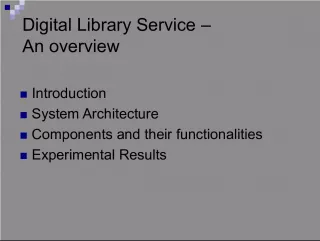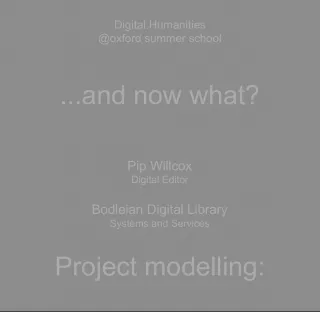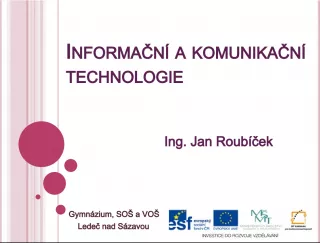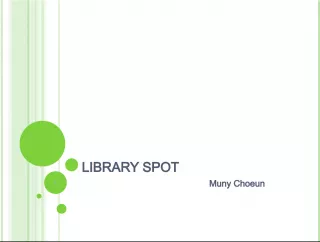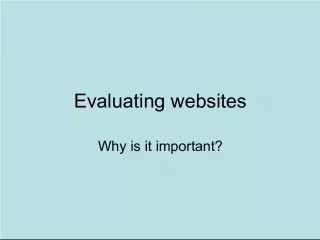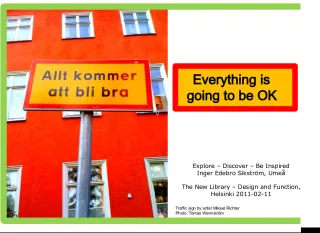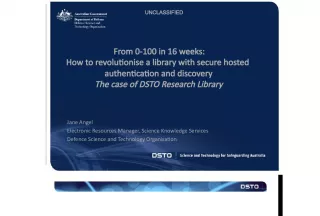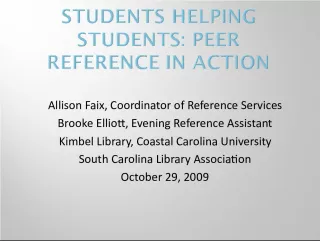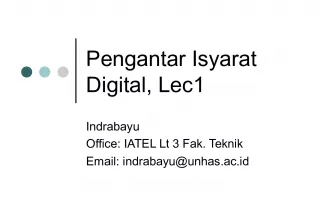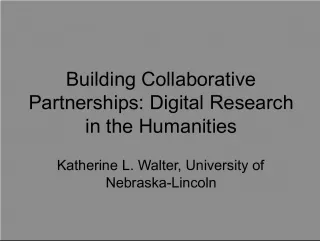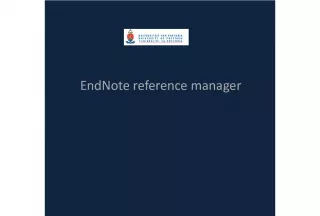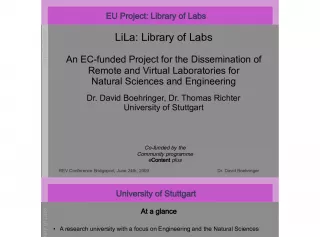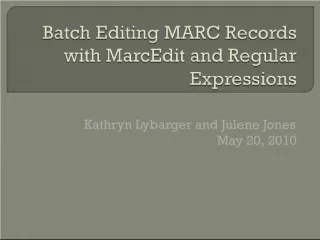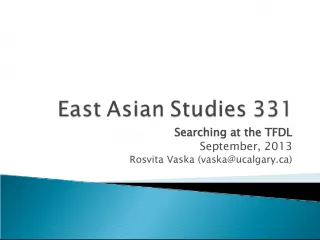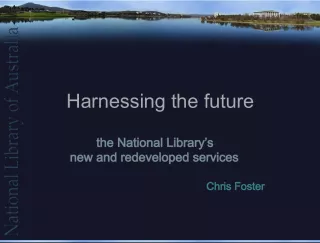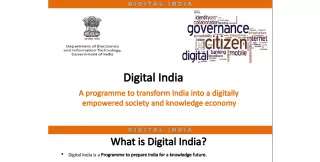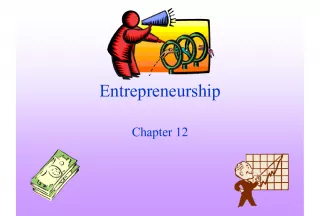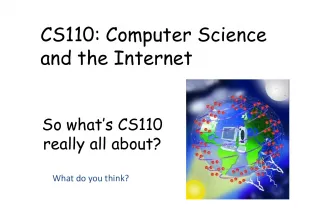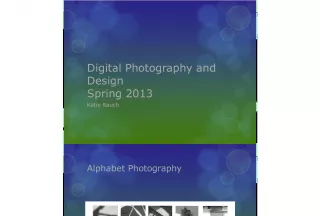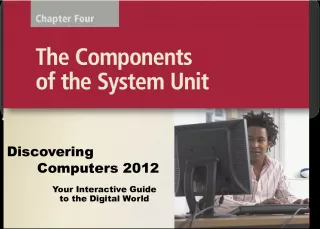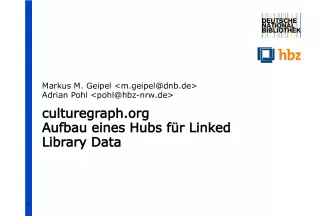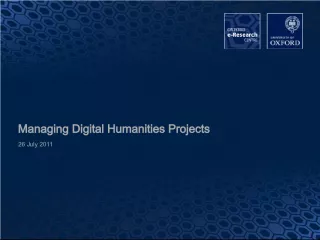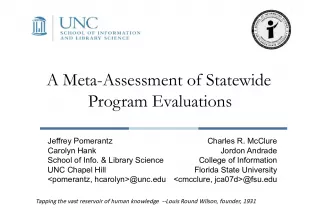The Library as Organizer of Digital Information


This presentation discusses the future of libraries and information centers and their role in organizing digital information. It highlights the importance of libraries in managing and disseminating digital content, and explores strategies for improving information access and retrieval.
- Uploaded on | 3 Views
-
 adrianamorales
adrianamorales
About The Library as Organizer of Digital Information
PowerPoint presentation about 'The Library as Organizer of Digital Information'. This presentation describes the topic on This presentation discusses the future of libraries and information centers and their role in organizing digital information. It highlights the importance of libraries in managing and disseminating digital content, and explores strategies for improving information access and retrieval.. The key topics included in this slideshow are library, digital information, organization, future, information access,. Download this presentation absolutely free.
Presentation Transcript
1. 1 The library as organizer of digital information Paul Nieuwenhuysen Vrije Universiteit Brussel Informatie- en Bibliotheekwetenschap, Universiteit Antwerpen, Belgi Lecture presented at University of Antwerp, UFSIA, September 2002, at the occasion of the one-day conference organised by VVBAD Which future for scientific libraries and documentation centers? These slides are available from http://www.vub.ac.be/BIBLIO/nieuwenhuysen/presentations/
2. 2 Contents / summary of this presentation 1. General: The future of libraries and information centres. 2 . More specific: The library as organizer of digital information.
3. 3 Libraries and information centres Evolution and future trends
4. 4 Libraries and information centres: evolution of their roles (Part 1) Collection development (hard copy documents) Cataloguing + classification (hard copy documents) User services: reference, user education Library as a physical meeting place Conservation (hard copy documents) ? ? ? ? ?
5. 5 Libraries and information centres: evolution of their roles (Part 2) Collection development (hard copy documents) Cataloguing + classification (hard copy documents) User services: reference, user education Library as a physical meeting place Conservation (hard copy documents) + Licensing access to digital information + Organizing access to digital information + Offering services in a networked environment + Library presence on the WWW or on the intranet + Conservation of digital documents or ensuring continuous access to digital documents
6. 6 Libraries and information centres: future trend More applications of information and communication technology (ICT).
7. 7 Libraries and information centres: future trend Decreasing physical, hard-copy document collections <=> Increasing impact of online access information sources Secondary, bibliographic databases WWW sites E-journals (E-books)
8. 8 Libraries and information centres: future trend = becoming invisible Disappearance of the library as a building / space / place Services offered by libraries become more virtual, less clearly visible. Is the ideal library invisible? Who wants to pay for an invisible library? Who wants to pay for invisible librarians? Classical libraries loose prestige, but access to information will still be important. ...
9. 9 Picture of the future library ;-)
10. 10 Libraries and information centres Organizing digital information
11. 11 Collection development in information centres: hard copy User / Reader Hard copy Collection development Information centre
12. 12 Collection development in information centres: hard copy User / Reader Searching + using Hard copy
13. 13 The digital/electronic/virtual library : scheme Structures , practices , and methods of physical libraries and archives Communication capabilities of electronic networking Computing power that is decreasing in price Digital / electronic / virtual library Digital / electronic / virtual library
14. 14 Collection development in information centres: hard + digital User / Reader Collection development Information centre Electronic, digital resources Hard copy
15. 15 Collection development in information centres: hard + digital User / Reader Searching Electronic, digital resources Hard copy
16. 16 Organiz ing access to information in information centres : hybrid libraries User / Reader Searching + using Hard copy + electronic, digital resources in an integrated , hybrid library
17. 17 Organiz ing access to information in information centres : the problem Users should be guided in finding their way through the maze, through the labyrinth that is formed by all available information systems and services.
18. 18 Organiz ing access to computer-based information in information centres (1) Several activities focus on organizing access to computer- based information: Making information accessible in the form of databases or web sites or combinations, on hard disks of computers or on CD-ROM disks or on DVD, on stand-alone microcomputers or on a networked computer.
19. 19 Organiz ing access to computer-based information in information centres (2) Providing users and potential users with access to micro computer workstations, to the local area network of the organization , and to the Internet with the WWW, so that they can easily identify and use online , computer- based information sources .
20. 20 Integrating access to all types of information in information centres However, a cess to all types of documents cannot be fully integrated in an ideal way. Some tools can help to integrate access. For instance: An integrated library management system that offers a catalogue that points not only to hard-copy documents, but also to online accessible information. A web site created, offered, and maintained by an information centre can point out how to access the hard copy documents and can offer hyperlinks to online accessible documents.
21. 21 Integrating access to all types of information in information centres Web site created, offered, and maintained by an information centre Catalogue created, offered, and maintained by an information centre
22. 22 Web sites developed by information centres: contents The contents of such a web site can consist of descriptions of information services offered (with electronic mail addresses or direct links) one or several catalogues or databases built by the information centre not built by the information centre, but made available online by the information centre links to information sources and services offered by external organisations
23. 23 Web sites developed by information centres: links The links to information sources and services offered by external organisations can bring the user to 1. bibliographic databases and electronic journals, for which is paid, because not everyone can have access! 2. search tools and a selection of interesting WWW sites that are accessible free of charge to anyone 3. databases and electronic journals that are accessible free of charge to everyone?
24. 24 Web sites developed by information centres: integration Scheme: bibliographic database searching bibliographic reference linking full text / complete version citations other documents
25. 25 Web sites developed by information centres: integration The web site made by a library can (and ideally should) integrate several more traditional products like links / pointers to information sources (including the traditional catalogue) the guide to using the library study material to become information literate Integration means here MORE than a set of hyperlinks.
26. 26 Organizing access to information in information centres: personalization? To improve access to digital information sources, the information centre can consider offering the possibility to adapt the user interface (the WWW site) to their personal preferences in terms of subject domain of the information preferred and often used information sources format, lay-out, colours of the interface This requires expertise that is not (yet) available in many information centres.
27. 27 Current awareness services provided by information centres The incoming flow of new available information is huge. The potential user/reader has limited time. So information centres can provide a current awareness service (alerting service): based on the interests of the user, the information centre sends the user descriptions of new information sources (plus an explanation of how to obtain the full version) OR directly the full version, because it is cheap to distribute electronic copies
28. 28 Organizing access to information in information centres: Internet access To allow clients to access to computer-based information resources, information centres 1. can provide access to computers (classical pcs or notebook pcs or) that are connected to the Internet, equipped with suitable software secured against viruses and attacks of users maintained well
29. 29 Organizing access to information in information centres: Internet access To allow clients to access to computer-based information resources, information centres 2. can support and stimulate the use of personal notebook computers of the incoming clients
30. 30 Organizing access to information in information centres: computer tools To assist the users / clients / readers in their usage and management of digital information, the information centre can provide computer tools such as access from everywhere to personal, protected disk space on a central computer text database management systems; local storage and retrieval systems annotation software Of course this requires expertise that is not (yet) available in many information centres.
31. 31 Education in finding and managing information To make sure that information sources are better appreciated, used, managed and exploited, the users and potential users should receive some education, training, instruction. This activity can be taken care of by schools, universities, or by the information cent res / libraries. Ideally this should be offered in several formats: as stand-alone, separate activities integrated with the pointers/links to information on the web site
32. 32 Organizing access to information in information centres: user feedback The system developed by the information centre to organize access to information should be adapted regularly to a changing world improved (within time and budget constraints of course) User feedback can be useful here. Users should be stimulated to provide comments. These comments should be directed to a person who is responsible for this kind of work. A suitable method here is the inclusion of feedback forms for email in the web pages.
33. 33 Organiz ing access to information : co-operation among organizations Co-operation with other organizations in the field of access to digital information may be desirable in purchasing access to electronic/digital sources (by forming consortia) development and maintenance of links to electronic/digital sources through the WWW development of study materials in the domain of information literacy development and maintenance of tools to manage digital sources
34. 34 Organiz ing access to information in organizations: evolution of roles
35. 35 Organiz ing access to information in organizations: evolution of roles
36. 36 Organiz ing access to information in organizations: evolution of roles
37. 37 Organiz ing access to information : co-operation among departments Co-operation with other departments in the organization/institute in the field of access to digital information may be desirable. For instance with centre for computing end networking managers of the local central electronic learning platform managers of distributed, departmental information centres managers of the local intranet
38. 38 Organiz ing access to information : the value of information? What is the value of information sources? Which price is reasonable and acceptable for access to information sources? These are simple questions but the answers are difficult. Debates on these questions by all stakeholders are going on almost continuously.
39. 39 Organiz ing access to information : the value of structured information? A related but different question is: What is the value of a good guide to information? Which price is reasonable and acceptable for ORGANISING / STRUCTURING information sources? This question is hard to answer, because the work, the efforts, the results and the benefits are less clearly visible than in the case of a well organised hard-copy collection However, it is also a question relevant to libraries, information centres, that spend more and more efforts in this area. How do managers and decision makers see this?
40. 40 Organiz ing access to digital information : some conclusions A new (additional) role for librarians. (More work) Still in full evolution No standard solutions. Competitors claim part of the same role! Co-operation can be useful in this field. Is the ideal librarian an invisible librarian?
